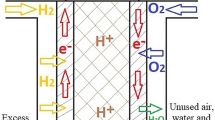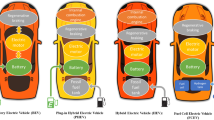Abstract
Electric-hydraulic hybrid power steering (E-HHPS) system, a novel device with multiple modes for commercial electric vehicles, is designed to realize both superior steering feel and high energy efficiency. However, inconsistent steering performance occurs in the mode-switching process due to different dynamic characteristics of electric and hydraulic components, which even threatens driving safety. In this paper, mode-switching strategy and dynamic compensation control method are proposed for the E-HHPS system to eliminate the inconsistency of steering feel, which comprehensively considers ideal assistance characteristics and energy consumption of the system. Then, the influence of disturbances on system stability is analyzed, and H∞ robust controller is employed to guarantee system robustness and stability. The experimental results demonstrate that the proposed strategy can provide a steering system with natural steering feel without apparent inconsistency and effectively minimize energy consumption.

















Similar content being viewed by others
Abbreviations
- DOF:
-
Degrees of freedom
- ECU:
-
Electronic control unit
- E-HHPS:
-
Electric-hydraulic hybrid power steering
- EHPS:
-
Electro-hydraulic power steering
- EPS:
-
Electric power steering
- HPS:
-
Hydraulic power steering
References
Li, L., Yang, C., Zhang, Y., et al.: Correctional dp-based energy management strategy of plug-in hybrid electric bus for city-bus route. IEEE Trans. Veh. Technol. 64, 2792–2803 (2015). https://doi.org/10.1109/TVT.2014.2352357
Zhang, S., Xiong, R., Zhang, C.: Pontryagin’s minimum principle-based power management of a dual-motor-driven electric bus. Appl. Energy 159, 370–380 (2015). https://doi.org/10.1016/j.apenergy.2015.08.129
Hur, J.: Characteristic Analysis of interior permanent-magnet synchronous motor in electrohydraulic power steering systems. IEEE Trans. Ind. Electron. 55, 2316–2323 (2008). https://doi.org/10.1109/TIE.2008.918402
Hur, J.: Development of an electric motor-driven pump unit for electro-hydraulic power steering with 42V power-Net. Int. J. Automot. Technol. 11, 593–600 (2010). https://doi.org/10.1007/s12239-010-0071-8
Lim, J., Jeon, J., Seong, J., et al.: Iterative electrical–thermal coupled simulation method of automotive power module used in electric power steering system. IEEE Access 9, 164712–164719 (2021). https://doi.org/10.1109/ACCESS.2021.3133530
Jeong, Y., Chung, C., Kim, W.: Nonlinear hybrid impedance control for steering control of rack-mounted electric power steering in autonomous vehicles. IEEE Trans. Intell. Transport. Syst. 21, 2956–2965 (2020). https://doi.org/10.1109/TITS.2019.2921893
Jang, J., Lee, J.M., Cho, S., et al.: Space-time kriging surrogate model to consider uncertainty of time interval of torque curve for electric power steering motor. IEEE Trans. Magn. 54, 1–4 (2018). https://doi.org/10.1109/TMAG.2017.2755459
Lu, S., Cen, S., Zhang, Y.: Driver model-based fault-tolerant control of independent driving electric vehicle suffering steering failure. Automot. Innov. 1, 85–94 (2018). https://doi.org/10.1007/s42154-018-0013-0
Peng, X., Shuo, H., Yaohua, L.: Study on a dual-motor driving electric power steering system for commercial vehicle. In: 2016 IEEE 11th Conference on Industrial Electronics and Applications (ICIEA), pp. 1949–1954. IEEE, Hefei (2016)
Zhao, W., Luan, Z., Wang, C.: Parameter optimization design of vehicle E-HHPS system based on an improved MOPSO algorithm. Adv. Eng. Softw. 123, 51–61 (2018). https://doi.org/10.1016/j.advengsoft.2018.05.011
Zhao, W., Luan, Z., Wang, C.: Parametric optimization of novel electric–hydraulic hybrid steering system based on a shuffled particle swarm optimization algorithm. J. Clean. Prod. 186, 865–876 (2018). https://doi.org/10.1016/j.jclepro.2018.03.180
Zhao, W., Zhou, X., Wang, C., Luan, Z.: Energy analysis and optimization design of vehicle electro-hydraulic compound steering system. Appl. Energy 255, 113713 (2019). https://doi.org/10.1016/j.apenergy.2019.113713
Guo, Z., Wu, H., Zhao, W., et al.: Coordinated control strategy for vehicle electro-hydraulic compound steering system. Proc. Inst. Mech. Eng. Part D J. Autom. Eng. 235, 732–743 (2021). https://doi.org/10.1177/0954407020949480
Tran, X.B., Hafizah, N., Yanada, H.: Modeling of dynamic friction behaviors of hydraulic cylinders. Mechatronics 22, 65–75 (2012). https://doi.org/10.1016/j.mechatronics.2011.11.009
Jang, S., Park, Y., Sung, S., et al.: Dynamic characteristics of a linear induction motor for predicting operating performance of magnetic levitation vehicles based on electromagnetic field theory. IEEE Trans. Magn. 47, 3673–3676 (2011). https://doi.org/10.1109/TMAG.2011.2153188
Wilhelm, F., Tamura, T., Fuchs, R., et al.: Friction compensation control for power steering. IEEE Trans. Contr. Syst. Technol. 24, 1354–1367 (2016). https://doi.org/10.1109/TCST.2015.2483561
Li, S., Niu, J., Cui, G., et al.: Research on friction compensation control for electric power steering system. Math. Probl. Eng. 2016, 1–5 (2016). https://doi.org/10.1155/2016/8470786
Deng, C., Mao, Y., Ren, G.: MEMS inertial sensors-based multi-loop control enhanced by disturbance observation and compensation for fast steering mirror system. Sensors. 16, 1920–1930 (2016). https://doi.org/10.3390/s16111920
Wang, J., Wang, Q., Jin, L., et al.: Independent wheel torque control of 4WD electric vehicle for differential drive assisted steering. Mechatronics 21, 63–76 (2011). https://doi.org/10.1016/j.mechatronics.2010.08.005
Nam, K., Oh, S., Fujimoto, H., et al.: Robust yaw stability control for electric vehicles based on active front steering control through a steer-by-wire system. Int. J Automot. Technol. 13, 1169–1176 (2012). https://doi.org/10.1007/s12239-012-0120-6
Wang, H., Man, Z., Shen, W., et al.: Robust control for steer-by-wire systems with partially known dynamics. IEEE Trans. Ind. Inf. 10, 2003–2015 (2014). https://doi.org/10.1109/TII.2014.2338273
Zou, S., Zhao, W.: Synchronization and stability control of dual-motor intelligent steer-by-wire vehicle. Mech. Syst. Signal Process. 145, 106925–106939 (2020). https://doi.org/10.1016/j.ymssp.2020.106925
Wu, F.K., Yeh, T.J., Huang, C.F.: Motor control and torque coordination of an electric vehicle actuated by two in-wheel motors. Mechatronics 23, 46–60 (2013). https://doi.org/10.1016/j.mechatronics.2012.10.008
Zhao, W.Z., Li, Y.J., Wang, C.Y., et al.: Research on control strategy for differential steering system based on H∞ mixed sensitivity. Int. J Automot. Technol. 14, 913–919 (2013). https://doi.org/10.1007/s12239-013-0100-5
Liang, Y., Li, Y., Yu, Y., et al.: Path-following control of autonomous vehicles considering coupling effects and multi-source system uncertainties. Automot. Innov. 4, 284–300 (2021). https://doi.org/10.1007/s42154-021-00155-z
Lee, D., Yi, K., Chang, S., et al.: Robust steering-assist torque control of electric-power-assisted-steering systems for target steering wheel torque tracking. Mechatronics 49, 157–167 (2018). https://doi.org/10.1016/j.mechatronics.2017.12.007
Zhao, W., Wang, C., Yu, L., et al.: Performance optimization of electric power steering based on multi-objective genetic algorithm. J. Cent. South Univ. 20, 98–104 (2013). https://doi.org/10.1007/s11771-013-1464-4
Hamamoto, M., Ohta, Y., Hara, K., et al.: A fundamental study of wing actuation for a 6-in-wingspan flapping microaerial vehicle. IEEE Trans. Robot. 26, 244–255 (2010). https://doi.org/10.1109/TRO.2010.2041266
Jung, S., Sinha, K., Suh, E.S.: Domain mapping matrix-based metric for measuring system design complexity. IEEE Trans. Eng. Manag. (2020). https://doi.org/10.1109/TEM.2020.3004561
Zhu, Y., Ma, L.: Composite chattering-free discrete-time sliding mode controller design for active front steering system of electric vehicles. Nonlinear Dyn. 105, 301–313 (2021). https://doi.org/10.1007/s11071-021-06465-5
Jiang, Y., Deng, W., Wu, J., et al.: Adaptive steering feedback torque design and control for driver–vehicle system considering driver handling properties. IEEE Trans. Veh. Technol. 68, 5391–5406 (2019). https://doi.org/10.1109/TVT.2019.2908987
Wu, Y., Li, B., Zhang, N., et al.: Rear-steering based decentralized control of four-wheel steering vehicle. IEEE Trans. Veh. Technol. 69, 10899–10913 (2020). https://doi.org/10.1109/TVT.2020.3020154
Du, H., Shi, J., Chen, J., et al.: High-gain observer-based integral sliding mode tracking control for heavy vehicle electro-hydraulic servo steering systems. Mechatronics 74, 102484–102493 (2021). https://doi.org/10.1016/j.mechatronics.2021.102484
Qu, S., Fassbender, D., Vacca, A., et al.: A high-efficient solution for electro-hydraulic actuators with energy regeneration capability. Energy 216, 119291–119310 (2021). https://doi.org/10.1016/j.energy.2020.119291
Shang, Y., Li, X., Qian, H., et al.: A novel electro hydrostatic actuator system with energy recovery module for more electric aircraft. IEEE Trans. Ind. Electron. 67, 2991–2999 (2020). https://doi.org/10.1109/TIE.2019.2905834
Tao, Y.: A new control framework of electric power steering system based on admittance control. IEEE Trans. Contr. Syst. Technol. 23, 762–769 (2015). https://doi.org/10.1109/TCST.2014.2325892
Jensen, M., Tolbert, A., Wagner, J., et al.: A customizable automotive steering system with a haptic feedback control strategy for obstacle avoidance notification. IEEE Trans. Veh. Technol. 60, 4208–4216 (2011). https://doi.org/10.1109/TVT.2011.2172472
Li, Z., Zhao, Y., Xu, K., et al.: Research on stability control method of vehicle based on steering torque superposition. IEEE Access. 8, 80518–80526 (2020). https://doi.org/10.1109/ACCESS.2020.2990965
Cao, M., Hu, C., Wang, R., et al.: Compensatory model predictive control for post-impact trajectory tracking via active front steering and differential torque vectoring. Proc. Inst. Mech. Eng. Part D: J. Autom. Eng. 235, 903–919 (2021). https://doi.org/10.1177/0954407020979087
Liu, Y., Alsaadi, F., Yin, X., et al.: Robust H∞ filtering for discrete nonlinear delayed stochastic systems with missing measurements and randomly occurring nonlinearities. Int. J. Gen Syst. 44, 169–181 (2015). https://doi.org/10.1080/03081079.2014.973730
Javed, S., Uppal, A., Samar, R., et al.: Design and implementation of multi-variable H∞ robust control for the underground coal gasification project Thar. Energy 216, 119000–119012 (2021). https://doi.org/10.1016/j.energy.2020.119000
Lee, Y., Moon, Y., Kwon, W., et al.: Delay-dependent robust H∞ control for uncertain systems with a state-delay. Automatica 40, 65–72 (2004). https://doi.org/10.1016/j.automatica.2003.07.004
Misgeld, B., Werner, J., Hexamer, M.: Robust and self-tuning blood flow control during extracorporeal circulation in the presence of system parameter uncertainties. Med. Biol. Eng. Comput. 43, 589–598 (2005). https://doi.org/10.1007/BF02351032
Shen, Q., Wang, D., Zhu, S., et al.: Robust control allocation for spacecraft attitude tracking under actuator faults. IEEE Trans. Control Syst. Technol. 25, 1068–1075 (2017). https://doi.org/10.1109/TCST.2016.2574763
Saadat, M., Shirazi, F., Li, P.: Modeling and control of an open accumulator compressed air energy storage (CAES) system for wind turbines. Appl. Energy 137, 603–616 (2015). https://doi.org/10.1016/j.apenergy.2014.09.085
State Bureau of Technical Supervision. GB/T 6323.4-94. Controllability and stabilitytest procedure for automobiles—returnability test. China.
Acknowledgements
The research presented in this work was supported by the Jiangsu Key R & D Plan under Grants BE2022053-3.
Author information
Authors and Affiliations
Corresponding author
Ethics declarations
Conflict of interest
The authors declare that they have no known competing financial interests or personal relationships that could have appeared to influence the work reported in this paper.
Additional information
Academic Editor: Xiaodong Wu
Rights and permissions
Springer Nature or its licensor (e.g. a society or other partner) holds exclusive rights to this article under a publishing agreement with the author(s) or other rightsholder(s); author self-archiving of the accepted manuscript version of this article is solely governed by the terms of such publishing agreement and applicable law.
About this article
Cite this article
Luan, Z., Zhao, W. & Wang, C. Mode Switching and Consistency Control for Electric-Hydraulic Hybrid Steering System. Automot. Innov. 7, 166–181 (2024). https://doi.org/10.1007/s42154-022-00211-2
Received:
Accepted:
Published:
Issue Date:
DOI: https://doi.org/10.1007/s42154-022-00211-2




